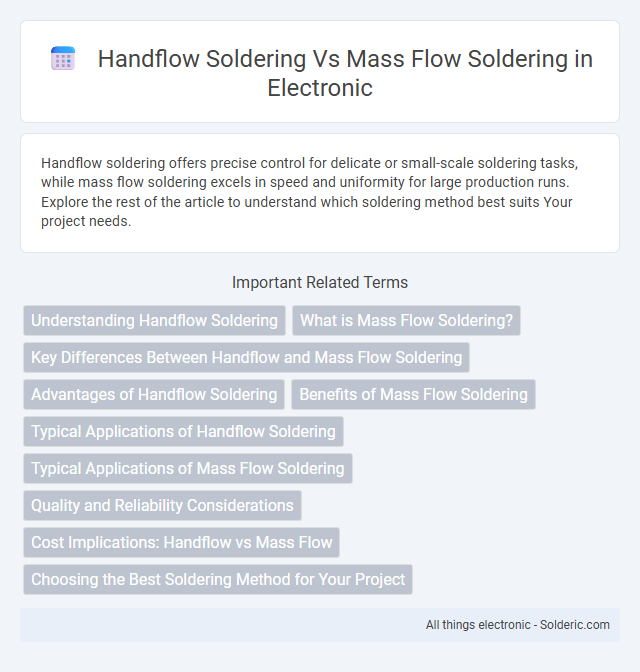Handflow soldering offers precise control for delicate or small-scale soldering tasks, while mass flow soldering excels in speed and uniformity for large production runs. Explore the rest of the article to understand which soldering method best suits Your project needs.
Comparison Table
| Aspect | Handflow Soldering | Mass Flow Soldering |
|---|---|---|
| Definition | Manual soldering process using hand-held tools. | Automated soldering using controlled mass flow systems. |
| Precision | Operator-dependent precision and consistency. | High precision with consistent, repeatable results. |
| Production Volume | Suitable for low to medium volume production. | Ideal for high volume, mass production. |
| Speed | Slower, limited by manual skill and pace. | Faster throughput with automated operation. |
| Cost | Lower initial setup cost; higher labor cost. | Higher initial investment; lower labor cost over time. |
| Quality Control | Varies based on technician skill and experience. | Consistent quality with real-time process monitoring. |
| Applications | Prototyping, repairs, small batch production. | Mass manufacturing, automotive, consumer electronics. |
| Equipment | Basic soldering iron, manual flux application. | Automated soldering machines with precise flow control. |
Understanding Handflow Soldering
Handflow soldering involves manually applying molten solder using a soldering iron, giving you precise control for delicate or complex electronic components. This technique is ideal for small-scale production, prototyping, or repair work where accuracy and flexibility are crucial. Unlike mass flow soldering, it allows for targeted solder joints without the need for expensive equipment or large batch processing.
What is Mass Flow Soldering?
Mass flow soldering is an automated soldering process that uses a continuous, evenly distributed jet of heated solder to create uniform solder joints on electronic components. This technique ensures consistent temperature control and precise solder flow, improving the quality and reliability of mass-produced circuit boards. Unlike handflow soldering, mass flow soldering enhances production speed and repeatability in high-volume manufacturing environments.
Key Differences Between Handflow and Mass Flow Soldering
Handflow soldering utilizes manual or semi-automatic techniques allowing precise control over individual components, whereas mass flow soldering employs fully-automated systems designed for high-volume production and uniform solder application. The key differences lie in throughput rates, with handflow suitable for small batches or prototyping, and mass flow optimized for consistent quality in large-scale manufacturing. Temperature profiles and solder delivery mechanisms also vary, with mass flow systems incorporating advanced preheating and controlled wave soldering for efficiency and reduced defects.
Advantages of Handflow Soldering
Handflow soldering offers precise control and flexibility ideal for intricate or low-volume electronics assembly, allowing you to manually adjust solder application for each joint. This method reduces the risk of thermal damage to sensitive components due to localized heating, enhancing product reliability. It also supports quick prototyping and repair tasks without the need for extensive setup or investment in complex equipment.
Benefits of Mass Flow Soldering
Mass flow soldering offers superior temperature control and consistent solder joint quality compared to handflow soldering, reducing defects and improving reliability in high-volume production. This automated process enhances efficiency by enabling faster processing speeds and minimizing human error. Your manufacturing yield benefits from the uniform heat distribution and precision achievable only with mass flow soldering systems.
Typical Applications of Handflow Soldering
Handflow soldering is predominantly used in prototype development, small batch production, and repair or rework of electronic assemblies where precision and manual control are critical. It excels in applications such as aerospace electronics, medical devices, and custom circuit boards where component sensitivity and intricate layouts demand careful handling. The technique supports fine-pitch components and mixed technology assemblies, making it indispensable for specialized manufacturing and complex assembly tasks.
Typical Applications of Mass Flow Soldering
Mass flow soldering is typically used in high-volume electronic manufacturing, such as in the production of printed circuit boards (PCBs) for consumer electronics, automotive components, and medical devices. It ensures precise control of soldering parameters, improving consistency and quality in applications requiring reliable electrical connections and minimal thermal damage. Your manufacturing process benefits from mass flow soldering when high throughput and uniformity are crucial for assembling complex or delicate electronic components.
Quality and Reliability Considerations
Handflow soldering offers precise control and is ideal for small-scale or complex assemblies, ensuring high-quality joints when performed by skilled operators. Mass flow soldering, including wave and selective soldering, delivers consistent solder application and excellent repeatability, enhancing reliability for high-volume production. Variations in heat distribution and solder volume in handflow can impact consistency, whereas mass flow systems maintain tighter process controls to minimize defects and improve overall solder joint integrity.
Cost Implications: Handflow vs Mass Flow
Handflow soldering typically incurs lower upfront equipment costs but higher labor expenses due to manual operation, making it more budget-friendly for small-scale or prototype production. Mass flow soldering requires significant capital investment in automated machinery, leading to higher initial costs but significantly reducing per-unit labor expenses and increasing throughput efficiency. Your choice between handflow and mass flow soldering should consider production volume and long-term cost benefits, with mass flow offering better scalability for high-volume manufacturing.
Choosing the Best Soldering Method for Your Project
Choosing the best soldering method for your project depends on factors such as production volume, precision requirements, and cost efficiency. Handflow soldering offers flexibility and control for small batches or intricate tasks, while mass flow soldering excels in high-volume manufacturing by ensuring consistency and speed. By evaluating these aspects, you can determine which soldering technique aligns best with your project's demands and quality standards.
Handflow soldering vs mass flow soldering Infographic

 solderic.com
solderic.com